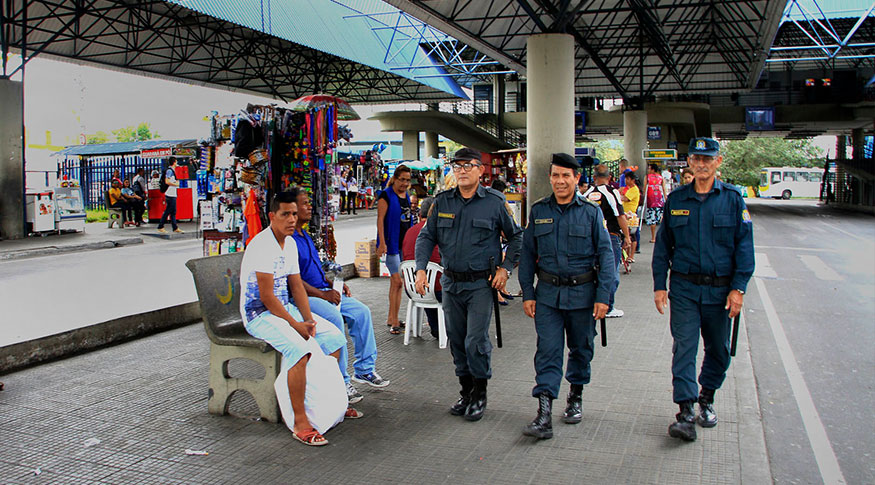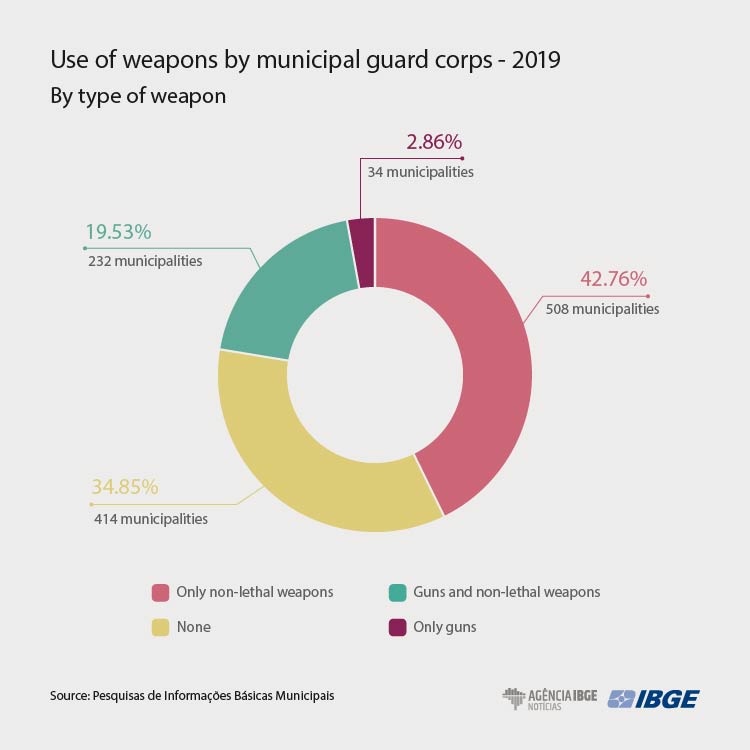Munic and Estadic 2019
Proportion of municipalities with armed Municipal Guard corps increases to 22.4%
December 02, 2020 10h00 AM | Last Updated: December 16, 2020 04h13 PM
Highlights
- 21.3% of the municipalities in Brazil, a total 1188, reported the existence of Municipal Guard corps.
- In 34.8% of the municipalities with a Municipal Guard, members carried no type of weapons.
- Municipal Guard corps had 84.4% of men and 15.6% of women.
- 75.6% of the cities with a Municipal Guard promoted professional training programs.
- The number of state secretariats dealing exclusively with Public Security fell from 23, in 2014, to 19, in 2019.
- 23.6% of the municipalities have a framework structure for security policies.

The percentage of municipalities where the Municipal Guard used only guns or guns and non-lethal weapons went from 15.6%, in 2014, to 22.4%, in 2019. A total 34.8% of the municipalities which had a Municipal Guard carried neither type of weapon. Data comes from the IBGE's Survey of Basic Municipal Information, released today (2).
Gun bearing by Municipal Guards has been legal, since the promulgation of the Disarmament Statute, in state capitals, municipalities with more than 500 thousand residents and in municipalities with a population between 50 thousand and 500 thousand residents, while corps are on duty. In spite of that, the survey shows there are municipalities where Municipal Guard members do not carry weapons, despite legal permission. The use of weapons in municipalities not covered by law has also been reported.

In addition to that, according to the Disarmament Statute, gun bearing permission by the municipal guard is conditioned to the existence of internal supervision and control. Despite that obligation, which is reinforced in the Municipal Guard Institute, only 46.8% of the municipalities in charge of those corps reported having implemented some type of internal, external or social control.
“In 2019, 21.3% of the municipalities, a total 1,188, reported the existence of municipal guards. In 2014, that figure was 1081,” says Vânia Pacheco, manager of the survey as she highlights that municipalities in the Northeast and with higher population density were the ones with the biggest percentages of Municipal Guard corps.
The percentage of municipalities with Municipal Guard increased significantly in the states of Rio de Janeiro, Alagoas, Pernambuco, Maranhão and Amazonas. As for the number of members, the survey showed the low percentage of women in those corps remained: men made up 84.4% and women, 15.6%. In 2009, women were 13.4% of the total.
Another aspect dealt with was the occurrence of professional training programs for those professionals. In 2019, 75.6% of the municipalities that have such corps promoted that type of program. Teaching and improvement courses took place in 72.8% of the municipalities that have a Municipal Guard. The most recurrent topics were personal defense, first aid, use of non-lethal weapons and use of strength.
Number of exclusive public security secretariats records decrease
According to the Survey of Basic Municipal Information (Estadic), also released today (2) by the IBGE, the number of state secretariats dealing exclusively with public security fell from 23, in 2014, to 19, in 2019. Seven states had secretariats shared between public security and others, such as social defense and justice.
In terms of public security management by municipal administration, a framework directed to this segment was present in 23.6 of the municipalities.
“Although public security is a state policy, the municipalities have advanced towards a framework to deal exclusively with the public security segment,” Vânia says.
In municipalities with more than 50 thousand residents, there is a managing body for public security in the administration of more than 60% of the municipalities, whereas in those with more than 500 thousand municipalities, the percentage is 97.9%. The biggest percentages of municipalities with a management body are located in the Southeast and Northeast Regions, which have the highest population density figures.
The only state that did not answer the questionnaire on public security management when the survey was on the field was Rio de Janeiro. Among the 27 Federation Units, 17 had a Public Security State Council and 23 had secretariats dealing with the defense of human rights.
Number of municipalities with a police station decreases
Munic investigated the existence of police stations in the Brazilian municipalities and the percentage of coverage went from 76.9%, in 2014, to 73.5%, in 2019. The decrease was mainly observed in small municipalities, with up to 20 thousand residents. Coverage increased in municipalities with more than 500 thousand residents.
Women’s police stations are the most commonly seen in Brazilian municipalities, among all branches: 7.9% of the municipalities have at least one station.
Among the 26 security managers, 21 are men and all of them are men
All the 26 state security managers surveyed in 2019 were men between 39 and 64 years of age, and 21 of them were white. In terms of level of schooling, nine managers had a higher education degree, whereas 17 had finished their graduate studies.
Despite the high percentage of men in the police corps, female participation has increased. In 2014, the percentage of women in the Military Police of Brazil was 9.8% and increased to 11% in 2019. Female police officers are mostly present in Amapá (22.8%) and least in Rio Grande do Norte (2.4%).
As for Civil Police, 27.6% in 2019 were women. In 2014, the percentage was 26.4%. The biggest proportion of female civil police officers was that of Rio Grande Sul (38,0%), and the smallest, in Piauí (15.8%).
There was a decrease in the number of members both in Military and in Civil Police in five years. In 2014, there were 425,248 professionals in the Military Police and that number fell to 416,923 in 2019. Members of Civil Police fell from 117,642 police officers in 2014 to 117,228 in 2019.
23 Federation Units had Human Rights secreariats
Among the 27 Federation Units, 23 had a Secretariat for Human Rights. Five Federation Units had na exclusive secretariat: Maranhão, Rio Grande do Norte, Federal District, Espírito Santo and Rondônia. In most other states, the secretariat was linked to the social assistance field. In Goiás, Santa Catarina and Amapá, the sector was under another secretariat.
“Considering municipalities, 44.5% of them reported having proper structure to deal with human rights policies. That amounted to 2,480 municipalities in 2019, a little more than in 2014,” Ms. Pacheco says.
Estadic also shows that all the Federation Units had councils for Rights of Children and Adolescents, Rights of the Elderly Persons and Rights of Persons with Special Needs. Only four states had all the councils surveyed: Paraíba, Rio de Janeiro, São Paulo and Rio Grande do Sul.
“In the municipalities, the biggest percentages are of those councils, with the Children and Adolescents Council in 98.5% of them, Rights of the Elderly persons in 72.4% and Right of Persons with Special Needs in 24.9%.”. Councils for Lesbians, Gays, Transsexuals and Queers were present in 0.9% and 0.3% dos of the municipalities, respectively.




















